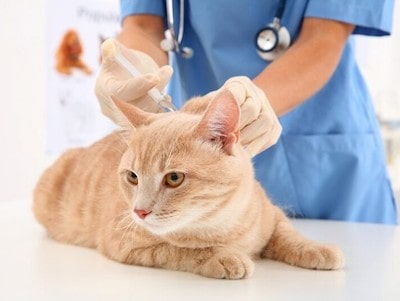As responsible pet owners, we always strive to ensure the well-being of our feline friends, especially when it comes to their health and medical needs.
Just like humans, cats can sometimes fall ill and require treatment, including the use of antibiotics like penicillin. However, determining the appropriate dosage of penicillin for cats can be a daunting task, considering their unique physiology and sensitivities.
That’s why we’ve prepared this comprehensive guide to help you navigate the complexities of administering penicillin to your beloved cat.
Whether you’re a first-time cat owner or simply seeking accurate information, read on to discover the essential insights and guidelines for safely and effectively giving penicillin to your feline companion.
What Is Penicillin and How Does it Work?
Penicillium is a species of mould that naturally produces penicillin. Alexander Fleming found that the mould prevented bacterial development, which led to his discovery of it in 1928.
Although other altered varieties of penicillin have since been created, the original formulation is still in use today.
Penicillin works by interfering with the cell wall of bacteria. The cell wall is a protective layer that surrounds the bacterial cell and gives it shape and strength.

Penicillin stops bacteria from building or mending their cell walls, which leads to their bursting and death. In particular, penicillin works well against gram-positive bacteria, which have strong cell walls.
However, some bacteria have developed resistance to penicillin, either by producing enzymes that destroy it or by changing their cell wall structure.
When Is Penicillin Prescribed for Cats?
Penicillin is usually prescribed for cats when they have a bacterial infection that is sensitive to this drug. Some common conditions that may require penicillin treatment are:
- Urinary tract infections (UTIs): These are infections of the bladder, urethra, or kidneys caused by bacteria such as Escherichia coli or Staphylococcus spp. Symptoms may include frequent urination, blood in urine, straining to urinate, or licking the genital area.
- Soft tissue infections: These are infections of the skin, muscles, tendons, or ligaments caused by bacteria such as Streptococcus spp. or Pasteurella spp. Symptoms may include wounds, abscesses, swelling, pain, or fever.

- Ear infections: These are infections of the outer, middle, or inner ear caused by bacteria such as Pseudomonas spp. or Proteus spp. Symptoms may include ear discharge, odor, scratching, shaking, or tilting the head.
- Respiratory infections: These are infections of the nose, throat, lungs, or airways caused by bacteria such as Bordetella bronchiseptica or Mycoplasma spp. Symptoms may include sneezing, coughing, nasal discharge, difficulty breathing, or loss of appetite.
- Skin infections/lesions: These are infections of the skin caused by bacteria such as Staphylococcus spp. or Corynebacterium spp. Symptoms may include hair loss, itching, redness, crusts, or scabs.
Factors Affecting Penicillin Dosage for Cats
The dosage of penicillin for cats varies depending on the specific infection and the individual cat. Therefore, it is important to consult a veterinarian before giving penicillin to a cat and follow their instructions carefully.
Generally speaking, the dosage of penicillin for cats ranges from 10,000 to 40,000 units per kilogram of body weight per day, divided into two or three doses.

However, this may vary depending on the type and concentration of penicillin, the route of administration, and the response of the cat. For example:
- For urinary tract infections, penicillin V may be given orally at a dose of 15,000 units per kilogram every 6 to 8 hours.
- For soft tissue infections, procaine penicillin G may be given intramuscularly or subcutaneously at a dose of 22,000 to 44,000 units per kilogram every 12 to 24 hours.
- For ear infections, potassium penicillin G may be given intravenously at a dose of 20,000 to 25,000 units per kilogram every 6 hours.
- For respiratory infections, amoxicillin-clavulanate may be given orally at a dose of 12.5 to 25 milligrams per kilogram every 8 to 12 hours.
- For skin infections or lesions, benzathine penicillin G may be given intramuscularly at a dose of 12,000 to 40,000 units per kilogram every 48 hours.
These are just some examples of different penicillin dosages for different scenarios. The veterinarian will determine the best dosage for each cat based on their diagnosis, medical history, and physical examination.
What Are the Side Effects and Precautions of Penicillin for Cats?
Penicillin is generally safe and well-tolerated by most cats. However, some cats may experience side effects or allergic reactions to this drug. Some of the possible side effects are:
- Hives and other skin rashes
- Itchiness
- Facial swelling
- Difficulty breathing
- Vomiting
- Diarrhea
- Loss of appetite
- Anaphylaxis (a severe and life-threatening allergic reaction)
If you notice any of these signs in your cat after giving them penicillin, stop the treatment and contact your veterinarian immediately. Your cat may need emergency care and a different antibiotic.

Some precautions that you should take when giving penicillin to your cat are:
1) Do not give penicillin to your cat if they are allergic to it or any other penicillin-like drugs (such as ampicillin or amoxicillin).
2) Do not give penicillin to your cat if they have a history of kidney disease or liver disease.
3) Do not give penicillin to your cat if they are pregnant or nursing unless directed by your veterinarian.
4) Do not give penicillin to your cat if they are taking other medications that may interact with it (such as antacids, probenecid, allopurinol, or tetracyclines).
5) Do not mix injectable forms of penicillin in the same syringe with other medications unless directed by your veterinarian.
6) Do not give penicillin to your cat more often or longer than prescribed by your veterinarian.
7) Do not give penicillin to your cat that is meant for human use or for other animals.
8) Store penicillin in a cool and dry place away from light and moisture. Follow the storage directions provided on the label.
9) Dispose of any unused or expired penicillin safely and according to local regulations.
FAQs
Can I give penicillin to my cat without a veterinarian’s prescription?
It is strongly recommended to never administer any medication, including penicillin, to your cat without the guidance and prescription of a qualified veterinarian. Veterinarians consider various factors such as the cat’s specific condition, weight, age, and overall health before prescribing any medication.
How is the dosage of penicillin determined for cats?
The dosage of penicillin for cats is determined by a veterinarian based on several factors. These factors include the cat’s weight, age, overall health, the severity of the infection, and the specific type of penicillin being used. It is crucial to consult with a veterinarian to obtain the correct dosage and instructions for administering penicillin to your cat.
What should I do if I miss a dose of penicillin for my cat?
If you accidentally miss a dose of penicillin for your cat, it is important not to double up on the next dose. Instead, consult your veterinarian for guidance. They may advise you to administer the missed dose as soon as you remember or adjust the subsequent doses accordingly. It is crucial to follow the veterinarian’s instructions to maintain the effectiveness of the medication.
Can penicillin interact with other medications my cat is taking?
Yes, penicillin can potentially interact with other medications that your cat may be taking. It is essential to inform your veterinarian about all the medications, including over-the-counter supplements or herbal remedies, that your cat is currently receiving. This allows the veterinarian to assess the potential for drug interactions and adjust the treatment plan accordingly to ensure the safety and effectiveness of the medications.
Conclusion
Penicillin is a useful antibiotic that can help treat and prevent various bacterial infections in cats. However, it is not a simple drug that can be given without proper guidance and care.
The dosage and administration of penicillin for cats depend on several factors, such as the type and severity of the infection, the weight and age of the cat, the form and concentration of penicillin, and the presence of any allergies or other medical conditions.
Therefore, it is important to consult a veterinarian before giving penicillin to a cat and follow their instructions carefully.
It is also important to watch out for any side effects or complications that may occur while giving penicillin to a cat and contact your veterinarian if you have any concerns.
By doing so, you can ensure that your cat receives the best possible treatment for their infection and stays healthy and happy.

Charlene Pare is the founder of Cat Likes Best. She manages and strategizes the content published on this website. When she isn’t working, she enjoys exploring the city around with her Ameican Shorthair kitty–Moli. Being a technocrat and an avid cat lover, she also writes on pet tech products and some of the featured articles.

